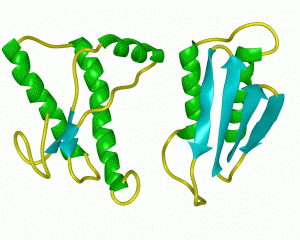TUESDAY, 15 SEPTEMBER 2015
Collinge and colleagues were originally analysing brain tissue from patients who had died from a totally different disease, Creutzfeldt-Jakob disease (CJD). Surprisingly, though, most of the patients also showed signs of Alzheimer’s disease, ranging from moderate to severe. The factor they had in common? All eight had been given growth hormone derived from human tissue.CJD and human growth hormone
CJD, like Alzheimer’s, is a neurodegenerative disease. It’s unusual because the pathology is caused by a protein, or prion, which is a misfolded version of a protein normally found in healthy neural tissue. The misfolded version can warp normal molecules of prion protein, converting them in turn into the pathogenic variant – which is also, unsurprisingly, much more stable than the normal version. The disease often has a decades-long incubation period, and is invariably fatal.
Humans only develop CJD by having a faulty version of the gene encoding prion protein (producing rare cases of ‘familiar’ CJD), or by having the warped protein introduced into the body. One high-profile example was the UK’s mad-cow disease scare, a CJD variant caused by eating contaminated tissue from cows infected with the bovine form of the disease. The other was human growth hormone, which is used to treat developmental defects. The first treatments started in the 1950s and used an extract from donated human pituitary gland (collected post-mortem). In 1985, though, these were stopped after doctors realised that prion-contaminated batches of growth hormone was causing CJD - as happened for the eight patients in the Nature study.
Alzheimer’s and the CJD study
Seven out of these eight patients had abnormal build-ups of another protein called amyloid-beta, which accumulates during Alzheimer’s, in their brain tissue. This by itself might not have been unusual if the patients hadn’t been too young to develop severe Alzheimer’s pathology. (The exception is familiar Alzheimer’s, which has a known genetic component and does develop quickly in younger patients. None of the CJD patients had the high-risk versions of the genes responsible.)
Maybe having CJD predisposed the seven patients to Alzheimer’s? Apparently not: in another group of younger CJD patients, who hadn’t been given contaminated growth hormone, only those with the high-risk genetic profile for familial Alzheimer’s showed amyloid-beta pathology. So maybe it was something else in the contaminated growth hormone? The researchers examined samples from pituitary glands, this time from patients with Alzheimer’s-like pathology; amyloid-beta protein turned up in several of the pituitary samples. Based on this evidence, they hypothesised that ‘seeds’ of amyloid-beta in the growth hormone could have spread the abnormal amyloid-beta accumulation in their CJD patients.
Don’t panic
This hypothesis is alarming. However, the study is not trying to rebrand Alzheimer’s disease as infectious; we still can’t catch it under any normal circumstances (like sneezing….). Also, while the idea of amyloid-beta ‘seeding’ isn’t actually new – it’s been done experimentally in laboratory animals – there isn’t conclusive evidence that it works the same way in humans. Nor is it completely clear what role amyloid-beta plays in Alzheimer’s disease, and whether it causes or just correlates with dementia.
Thankfully, therapeutic hormones are no longer contaminated with prion protein or amyloid-beta. The hormones now given to human patients, as well as animals in conventional agriculture, are recombinant. This means that they’re produced by bacteria, which are provided with a genetic sequence encoding only the protein sequence of that hormone. Unfortunately, this does leave surgical transmission – via contaminated transplants or instruments – as a source for potential amyloid-beta ‘seeds’. (If they do in fact exist; Collinge and colleagues have been trying to locate old stocks of the contaminated growth hormone, but haven’t yet been able to analyse for beta-amyloid contamination.)
…Still, an extra sterilisation protocol in operating theatres never hurt anyone.
Further reading
- The original Nature paper
- BBC and New Scientist media coverage
- Amyloid-beta seeding in laboratory animals
- Prion-contaminated surgical instruments are harder to sterilise

